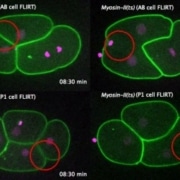Temperature-sensitive (ts) mutant proteins are great tools to analyze cell-regulative processes by temporally affected protein interactions. However, many observations are based on experiments where temperature shifts in the whole sample (e.g. embryos), and thus are missing spatial regulative aspects.
In the study of S.M. Hirsch et al. (nature methods, 2018) they present FLIRT, which stands for “fast local infrared thermogenetics”. This method combines two concepts:
1. ts-mutants for temporal (temperature depended) control within a sample
2. Local temperature jumps, induced by our UGA-42 Geo shape scanning system, equipped with a special IR-laser.
This combination allowed the researchers to get spatial & temporal control of cellular processes, namely the cell division of individual cells of a drosophila embryo during cell division (movie1). Furthermore, since the control via ts-mutants is a reversible process, the authors were not just able to stop division of individual cells within the embryo, but also re-initialize cell division at a later point in time (approx. 4 minutes after the laser was turned off; movie2)
Movie1: Stopping cell division by FLIRT
The movie shows four individual drosophila embryos at two-cell stage. FLIRT was performed either on the anterior (AB) or posterior (P1) site of the embryo (indicated by red circle). The two time-series on the left side show control samples without any ts-mutants. In both samples, cell division was not affected by local temperature-increase. The two time series on the right side show myosin-II (ts) mutants. In both cases the cell under control of FLIRT failed to divide, while the neighboring cell remained unaffected.
The movie shows four individual drosophila embryos at two-cell stage. FLIRT was performed either on the anterior (AB) or posterior (P1) site of the embryo (indicated by red circle). The two time-series on the left side show control samples without any ts-mutants. In both samples, cell division was not affected by local temperature-increase. The two time series on the right side show myosin-II (ts) mutants. In both cases the cell under control of FLIRT undergoes cell division shortly after the IR-laser was turned off.
Setup:
- Nikon Ti Spinning Disk
- 60x Plan-Apo Oil objective
Rapp OptoElectronic components:
- UGA-42 Geo (with IR modification)
- DL-1470 – 3W IR laser
Reference:
Hirsch, Sophia M., Sriramkumar Sundaramoorthy, Tim Davies, Yelena Zhuravlev, Jennifer C. Waters, Mimi Shirasu-Hiza, Julien Dumont, and Julie C. Canman. 2018. “FLIRT: Fast Local Infrared Thermogenetics for Subcellular Control of Protein Function.” Nature Methods. Springer US. doi:10.1038/s41592-018-0168-y.

